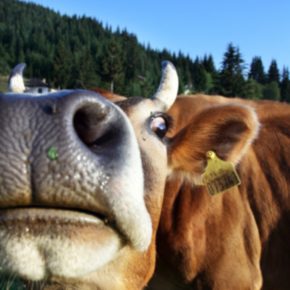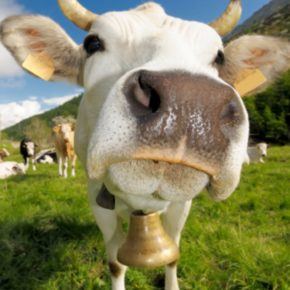 We’ve all heard of mad cows, cattle who are infected with Bovine Spongiform Encephalopathy (BSE), a neurodegenerative disease that causes the spongy deterioration of the brain and spinal cord. When the outbreak first took flight, little was known about the orientation of the disease. The cause has since been determined, that when you feed a normally herbivorous animal, bits and pieces of its cow counterparts, it ends up being a REALLY bad idea. When humans ingest the infectious tissues, we are also susceptible to contracting the human form of (BSE). As rare as this outbreak is and the number of people infected, what about all the other slights cattle face? Cows have a lot more to rumble about than just being turned into cannibalistic cattle: E. coli, rBGH (recombinant bovine growth hormone), mastitis, overcrowding, disease and less than desirable living environments– just to name a few. Factory feed lots have turned Daisy, into slabs of meat on four legs with living conditions to match.
We’ve all heard of mad cows, cattle who are infected with Bovine Spongiform Encephalopathy (BSE), a neurodegenerative disease that causes the spongy deterioration of the brain and spinal cord. When the outbreak first took flight, little was known about the orientation of the disease. The cause has since been determined, that when you feed a normally herbivorous animal, bits and pieces of its cow counterparts, it ends up being a REALLY bad idea. When humans ingest the infectious tissues, we are also susceptible to contracting the human form of (BSE). As rare as this outbreak is and the number of people infected, what about all the other slights cattle face? Cows have a lot more to rumble about than just being turned into cannibalistic cattle: E. coli, rBGH (recombinant bovine growth hormone), mastitis, overcrowding, disease and less than desirable living environments– just to name a few. Factory feed lots have turned Daisy, into slabs of meat on four legs with living conditions to match.
These distressed cattle are crowded in facilities often times knee deep in their own and its neighbors waste, pumped full of antibiotics, sick with disease, and made to eat an unnatural diet of genetically modified corn or soybean meal. The unsanitary conditions and the forced diet change couples together to make way for disease. E.coli resides in just about everything, however grass fed cows have much lower levels of E. coli residing in their digestive tract compared to cows fed an all grain diet- “vegetarian fed” doesn’t sound so good once you know what that equates to. Dairy cows pumped full of hormones to increase milk production, often suffer chronic mastitis- a blood, puss, and antibiotic dairy filled infusion is the end result of this practice; many other countries have banned the use of rBGH. Feed lots have a devastating impact on the environment as well, cows are like natural lawn workers they trim the lawn, fertilize the lawn and make way for new growth. Feed lots on the other hand have a rather taxing affect on the environment- cows produce large amounts of methane (yes from farting and poohing), in the natural process the methane is balanced with growth and germination the cows create during grazing, in factories it just adds to greenhouse gases. Transportation of the meat to retail chains and grocers is just another cost to add to the factory farmhouse practice.
If there are mad cows, it only stands to reason there are happy cows. A happy cow forages about in a field eating grass, moo’ing and poohing until it’s ushered to a new patch where it repeats the cycle. This image is plastered on dairy products and meat sold in the market, unfortunately this picture is far removed from reality. Happy cows have many health advantages over mad cows, rich in CLA (conjugated linoleic acid) a supplement commonly taken to help trim your waste line, wait I thought we could only drink pasteurized and homogenized skin milk to lose weight and stay healthy? Clean dairy also has a better omega-3 to 6 ratio, the american diet is plentiful in omega-6’s from all the refined grains and oils we ingest, but we are severely deficient in omega- 3’s. The tasty beef cakes also contain the 8 essential amino acids the human body cannot manufacture on its own. Much of the time meat in the market has been pumped full of preservatives so the meat can make the long trip from the slaughter house to the shelf as well. While factory farmed meat and dairy may cost less upfront, it ends up costing you more in the long run. If you eat diseased, nutrient void meat filled with preservatives, antibiotics, and hormones this ends up in your body and will create the same chain affect Grass fed and pasture raised ruminants, while more expensive, may save your pocket book from the increasing medical bills that crop up from poor health.


